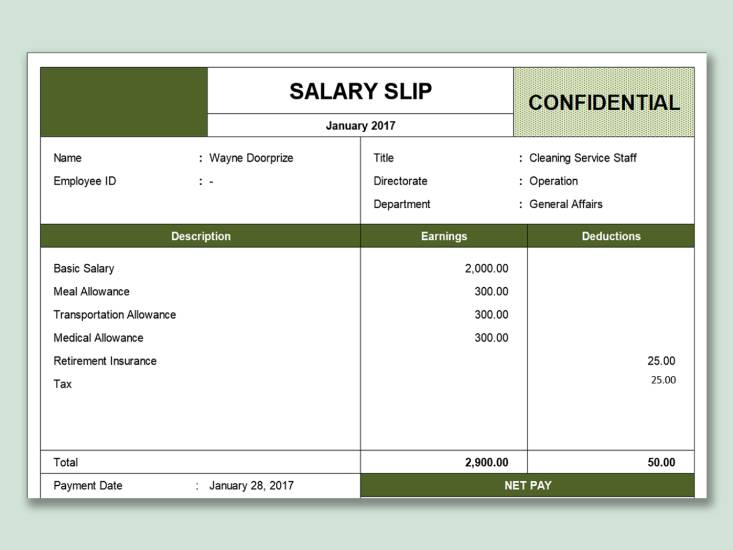In the realm of financial management, the salary slip stands as a crucial document that not only reflects the compensation an employee receives but also serves as a comprehensive record of various financial components. For employees, understanding the nuances of the salary slip is essential for financial planning and management. In this blog post, we will delve into the intricacies of the salary slip – its format, provide a sample template for download, discuss its importance, and break down the key components that make up this significant document.
Format of Salary Slip
The format of a salary slip may vary among organizations, but it generally includes standard sections that provide a clear breakdown of an employee's earnings and deductions. Here's a common structure found in most salary slips:
1. Employee Information
- Name
- Employee ID
- Designation
- Department
2. Earnings
- Basic Salary
- House Rent Allowance (HRA)
- Dearness Allowance (DA)
- Special Allowances
- Overtime Pay
- Bonus or Incentives
3. Deductions
- Provident Fund (PF)
- Professional Tax (PT)
- Income Tax
- Insurance Premiums (if applicable)
- Loan Repayments (if any)
4. Net Salary
The final amount an employee takes home after deductions.
- Employer Contributions:
- Employer's Provident Fund (EPF)
- Medical Insurance
- Gratuity
Also Read: Section 80GG of the Income Tax Act
Importance of Salary Slip
- Transparency: The salary slip provides transparency regarding the employee's earnings and deductions, fostering trust and understanding between the employer and employee.
- Financial Planning: Employees can use the salary slip as a tool for effective financial planning. By understanding the components, they can allocate funds for savings, investments, and monthly expenses more efficiently.
- Loan Applications: Financial institutions often require salary slips as a part of the documentation when processing loan applications. A detailed salary slip can expedite the loan approval process.
- Tax Compliance: The salary slip is a crucial document during tax filing. It outlines the taxable components, making it easier for employees to comply with tax regulations.
- Legal Validity: In case of any legal disputes or discrepancies, the salary slip serves as a legally valid document that can be used for reference.
Components Breakdown of Salary Slip
1. Basic Salary
This is the fixed amount paid to the employee before any allowances or deductions. It forms the basis for various calculations.
2. Allowances
- House Rent Allowance (HRA): Provided to employees to cover rental expenses.
- Dearness Allowance (DA): A cost-of-living adjustment to counter inflation.
- Special Allowances: Additional allowances specific to certain roles or responsibilities.
3. Overtime Pay
Compensation for hours worked beyond the standard work hours.
4. Bonus or Incentives
Additional payments based on performance, achieving targets, or company profits.
5. Provident Fund (PF)
A mandatory contribution towards the employee's retirement fund, with both the employer and employee making contributions.
6. Professional Tax (PT)
A state-level tax is deducted at source, the amount of which varies across states.
7. Income Tax
The portion of the employee's income that goes to the government as tax, is calculated based on the individual's tax slab.
8. Insurance Premiums
Deductions for various insurance policies provided by the employer, such as health or life insurance.
9. Loan Repayments
If an employee has taken any loans from the company, the repayments are deducted from the salary.
10. Net Salary
The final amount an employee receives after all deductions.
11. Employer's Provident Fund (EPF)
The employer's contribution to the employee's retirement fund.
12. Medical Insurance
Contributions made by the employer towards the employee's medical insurance.
13. Gratuity
A lump sum payment is made by the employer to the employee as a token of appreciation for the years of service.
Also Read: What is Maturity in Insurance?
Conclusion
In conclusion, the salary slip is not just a routine document handed out at the end of the month; it's a powerful tool that empowers employees with financial knowledge and facilitates smooth employer-employee relations. By understanding the format, utilizing sample templates, and comprehending the importance and components of the salary slip, employees can take charge of their financial well-being and make informed decisions about their money matters. Employers, in turn, play a pivotal role in ensuring that the salary slip is not just a piece of paper but a comprehensive guide that adds value to their workforce. As we navigate the intricate world of compensation, let us embrace the salary slip as a bridge to financial empowerment and stability.
*Tax benefits are as per the Income Tax Act, 1961, and are subject to any amendments made thereto from time to time’
The article is meant to be general and informative in nature and should not be construed as solicitation material. Please read the related product brochures for exclusions, terms and conditions, warranties, etc. carefully before concluding a sale.
Make responsible financial decisions. Consult with your financial advisor before making any decisions on insurance purchase.
